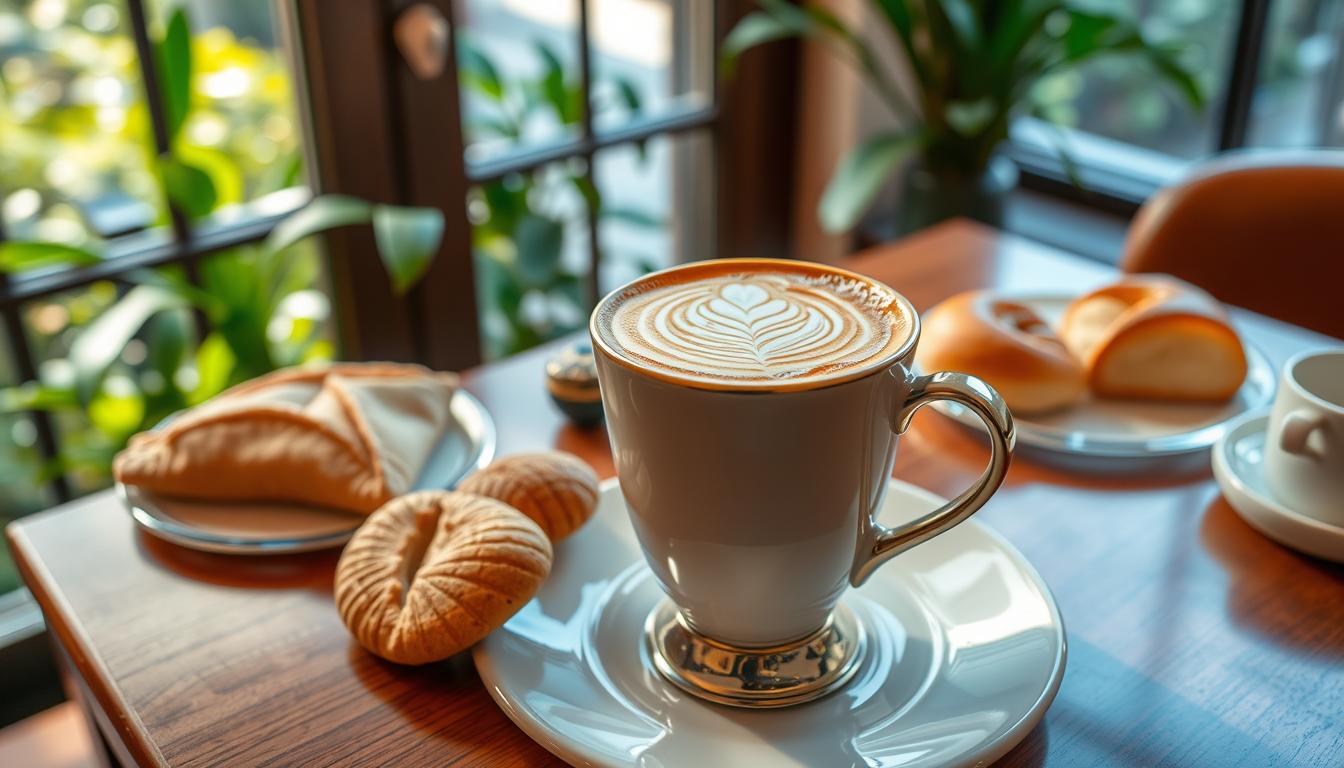Are you a coffee lover looking to improve your daily cup? Get ready for an exciting journey into the world of fancy coffee. Every sip is a taste adventure, from the green coffee beans to the expertly roasted ones.
This guide will take you deep into the art of artisanal roasts. You’ll learn how each step, from growing to roasting, shapes the coffee’s taste.
Key Takeaways
- Discover the fascinating journey of gourmet coffee, from sustainable farming to innovative brewing techniques.
- Explore the impact of processing methods, fair trade, and regional terroir on the flavor profiles of premium coffee.
- Learn to appreciate the complexity of single-origin and blended coffee varieties, as well as the science behind different roast levels.
- Elevate your coffee experience by mastering premium brewing methods and developing an eye for discerning flavor notes.
- Understand the importance of freshness and proper storage in preserving the exceptional taste of fancy coffee.
The Journey from Bean to Cup: Premium Coffee Origins
The path from bean to cup is a journey of skill and taste. At its core are the single-origin beans from special places. These places have the right climate, soil, and height. They shape the coffee flavor notes that make each cup special.
The Art of Sustainable Coffee Farming
Specialty coffee comes from small farms where farmers care for each plant. This personal touch, along with green farming, leads to top-notch single-origin beans. From picking the best cherries to protecting the environment, every step aims for the best third-wave coffee.
Processing Methods and Their Impact on Flavor
How coffee beans are processed after picking greatly affects their taste. Methods like washed, natural, or honey-processed change the coffee’s acidity, body, and taste. Knowing these details helps coffee lovers see the skill in each cup.
The Role of Fair Trade in Premium Coffee
Fair trade has been key in the premium coffee world. It ensures farmers get fair pay and promotes green farming. This fair approach boosts the quality and taste of single-origin beans. It also makes the third-wave coffee experience better for everyone.
Every step in the journey, from farm care to processing, adds to the amazing coffee flavor notes in premium coffee. By understanding this journey, coffee fans can explore the art and science of their favorite single-origin or third-wave coffee.

Exploring Global Regions of Fancy Coffee Production
The world of coffee is vast and full of different flavors. Each region adds its own special taste. As a coffee lover, exploring these places can make your coffee experience better.
Ethiopia is where coffee started. It has a sweet taste like syrup, with hints of blueberry and chocolate. The high mountains and old ways of making coffee give its beans a special flavor.
In Latin America, you’ll find coffee with a nutty smell and a smooth taste. Countries like Colombia and Jamaica focus on growing coffee the right way. They also care about fair trade and helping local communities.
Asian coffee is different, with a earthy taste and notes of blueberry or peanut. Places like Indonesia and Papua New Guinea have their own special coffee flavors. These are loved by coffee sommeliers and microroastery fans.
“Each region’s climate, altitude, and processing methods impart distinct flavors to the beans, creating a symphony of taste for the discerning coffee drinker.”
Looking into these different areas is a fun adventure. It lets you connect with coffee cultures from all over. Whether you like the bright tastes of African coffee or the deep flavors of South American, there’s so much to try.

Coffee Flavor Profiles and Roasting Techniques
Dive into the world of premium coffee flavors and uncover the art of roasting techniques. Whether you prefer the distinct notes of a single-origin bean or the complexity of a carefully crafted blend, understanding the impact of roasting on coffee flavor notes is key to unlocking your perfect brew.
Single-Origin vs. Blended Coffee Varieties
Explore the nuances between single-origin beans and blends. Single-origin coffees offer a unique flavor profile, reflecting the terroir and growing conditions of a specific region. Blended coffees, on the other hand, combine beans from multiple origins, creating a harmonious balance of artisanal roasts and third-wave coffee flavors.
The Science Behind Different Roast Levels
Roasting is key in developing flavors, balancing acidity, sweetness, and bitterness. Different roast levels impact flavor profiles, from the bright, fruity notes of a light roast to the rich, chocolatey tones of a dark roast. Discover how the roasting process influences the chemical composition of the beans, unleashing a world of complex flavor notes in your cup.
Identifying Complex Flavor Notes
Unlock the secrets of premium coffee tasting by learning to identify complex flavor notes like chocolate, vanilla, pumpkin, or caramel. Arabica beans are preferred for flavored coffees due to their smooth profiles, while whole beans preserve flavors better than pre-ground coffee. Explore the world of specialty flavors, from blueberry cobbler to crème brûlée, that push the boundaries of traditional coffee tastes.

“Developing tasting skills requires practice, time, and patience. Using a flavor wheel is recommended to calibrate taste buds and develop a common language for flavor descriptors.”
Mastering Premium Brewing Methods at Home
As a coffee connoisseur, learning to brew fancy coffee at home is an art. Whether you love pour-over brewing or want to improve your skills, learning premium brewing can make your coffee better.
First, find the right water-to-coffee ratio. Aim for 15:1, with a medium grind. Use water between 195°F and 205°F to bring out the best flavors.
- For pour-over brewing, bloom the grounds with a bit of water first. This lets the coffee release its carbon dioxide, improving the taste.
- Try different brewing methods like French press or Aeropress to see what your fancy coffee beans can do. Change the brewing time and ratio to find your perfect cup.
- Think about grind size, water quality, and your brewing equipment. Use the best tools and pay attention to details to make your coffee even better.
Learning these premium brewing methods will help you make amazing cups of fancy coffee. It will impress your friends and make your coffee time special. Learn how to brew the perfect cup of premium coffee at home and enjoy it even more.
“The true beauty of coffee lies in the journey from bean to cup. Mastering the art of premium brewing at home is a pursuit that rewards the senses and the soul.”
Conclusion
The world of fancy coffee is a fascinating journey. It’s filled with rich history, sustainable farming, and the quest for the perfect cup. You’ve learned about the complexities of specialty coffee origins and advanced brewing techniques.
This journey has shown you the importance of sustainable farming and fair trade. You now understand how these factors impact the coffee industry. You can explore different coffee varieties and find what you like best.
The coffee industry is always changing, with new trends and practices. As a coffee connoisseur, you should keep exploring and learning. Try new brewing methods, enjoy single-origin brews, and support sustainable coffee production.
Your journey of discovery is just starting. Embrace the passion and aroma of coffee. The world of specialty coffee is rewarding and full of possibilities.







